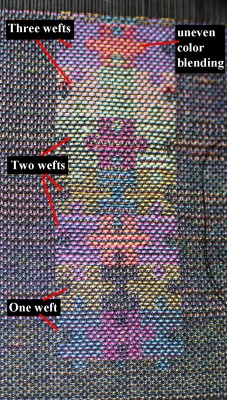I finished weaving the puzzle sampler last night, and have been examining it closely this morning, as the results are quite interesting. Here is a photo, which you would be well advised to click and take a closer look at (warning: it’s about 1 MB, so if you’re on dialup, that may take awhile):

Several things strike me as interesting here:
First, coverage is significantly better with two wefts and at its best with three wefts. The black weft largely does not show in mixes, though it does darken the tone slightly (see the two magenta center pieces; the bottom one is a single strand of magenta, the one in the middle of the sampler has one strand of magenta and one of black, and is slightly darker in tone as a result). I will weave up another sampler, removing the black, to get a better idea of blended effects.
Once you get up to three wefts on top (one on bottom), some interesting color effects start happening. In the top middle piece, the outer edges are reddish purple and the interior is yellow-orange. Why? It’s because, in the adjoining pieces, the yellow weft is on bottom. In the transition to the multicolor puzzle piece, yellow starts out mostly underneath the red, then transitions to being mostly on top of the red. The result is multiple colors. This does not seem to be consistent, though, as it doesn’t show up in all three-color puzzle pieces. Obviously there is something happening here which I don’t fully understand, but one thing is fairly obvious: you cannot use three wefts on top and one on bottom and expect all three wefts to show consistently. One will tend to slide under the others and be less visible.
So I have learned a lot in just a few short hours!
Now I will finish the bookmarks (which are essentially two repetitions of the sampler) and then weave the sampler again, this time with a different color (green?) instead of the black. I want to get a better idea of what happens in three-color blends and it is difficult to do that when one of your wefts disappears!
